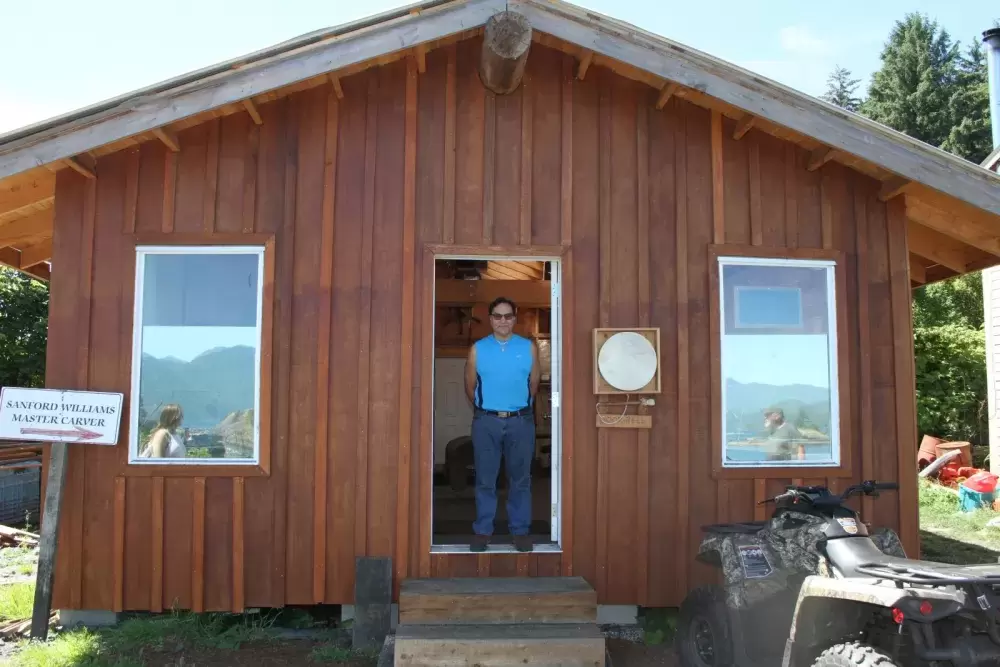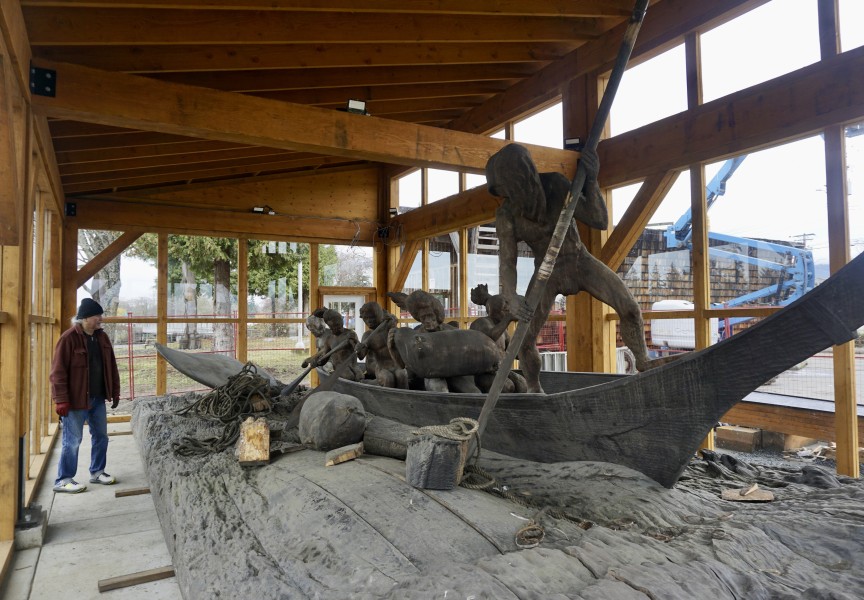What appear to be human skeletal remains have been recently uncovered at Yuquot, but it remains to be seen how old the bones are and who they belonged to.
Sanford Williams grew up in Yuquot, the ancestral home of Mowachaht/Muchalaht First Nation, and returns to the ancient village site on the southern edge of Nootka Island each summer to engage in his practice as a carver. On Thursday, June 1 he was digging into the side of a hill with his brother Darrell, who lives in Yuquot year-round, to build a back deck for his carving shed, when a discovery halted their operation.
“I was digging into the hill there and we came upon some bones,” said Sanford, who found the fragments about three feet into the earth. “We found quite a few that were with the jawbone.”
The bones have not been analyzed by an archaeologist, but photos sent to Ha-Shilth-Sa show what appears to be a piece of a jawbone with molars still intact, pieces of spine vertebrae, hip, ribs and leg or arm bones. The Ha-Shilth-Sa is not publishing these photos out of respect for any cultural sensitivities that may affect the deceased in an ancestral Nuu-chah-nulth site.
The Williams brothers had encountered other bones that appeared to be animal nearby on the hill, but stopped digging when what looked like human skeletal remains emerged “because they believe in their culture,” according to the family. Sanford isn’t aware of any human burials ever taking place on the hill.
“They were quite large bones,” remarked Sanford. “The jawbone, it’s got some burn marks there, like it’s been burned, like there was a fire on top of it or something.”
The family notified the Mowachaht/Muchalaht First Nation and the RCMP, which have since met to discuss the discovery.
“We have been in contact with local authorities regarding protocols that may apply,” said Tyee Ha’wilth Mike Maquinna in an email to Ha-Shilth-Sa. “Our elders will be discussing the concerns that may rise at this time.”
Roger Dunlop, the First Nation’s manager of Lands and Natural Resources, visited the site on Saturday, June 3. He believes they are two sets of old, partially-charred bones from a midden, or a historic refuse heap. Dunlop said the matter is being referred to the First Nation’s elders to determine what to do next.
For countless generations Yuquot was the summer home of the Mowachaht, and was once the capital for all 17 tribes of the Nootka Sound region, according to the Yuquot Agenda Paper that was published over 20 years ago to advocate for national commemoration of the site. Rich in archaeological signs of ancient habitation, studies conducted over the past half century have revealed evidence of 4,300 years of uninterrupted settlement at Yuquot.
Another two sets of bones were discovered by the ancient village site in 2017 and 2018 at the Nootka Lightstation. Before major upgrades were undertaken to the Canadian Coast Guard facility, an archaeological assessment was required, which found the remains of a woman aged 35-44 and an adolescent. Aquilla Archaeology radiocarbon dated the remains to be 1,000 years old.
Those bones were found in a garden by the lighthouse, leading archaeologist Colleen Parsley to determine that they were probably deposited there decades ago by a past lighthouse keeper who was moving soil from the Mowachaht village site to the facility’s garden.
During the winter that followed the discovery of the second set of remains, the bones were placed in cedar boxes and reinterned at an undisclosed site on Nootka Island by Mowachaht/Muchalaht elders according to the First Nation’s protocol.
The recently discovered jawbone piece appears similar to what is documented in the Yuquot Project, a multiple-volume archaeological study of the village site that was conducted from excavations in 1966. That dig uncovered the remails of nine people, which were found between six inches and three feet underground. The study determined that the remains belonged to multiple populations, due to signs of the deliberate alteration of the skull that was practiced in the past by various tribes on the Pacific coast.
“It should be remembered that the differences in head form do not represent differences in physical type, but, rather, differences in cultural practice,” wrote Jerome Cybulski, who authored this portion of the Yuquot Project.
Parsley isn’t surprised that bones are still being uncovered at Yuquot.
“It is totally predictable, and there will be thousands and thousands of people buried in that archaeological site,” she said.
In the centuries leading up contact with Europeans Nuu-chah-nulth people were known to intern their dead above the ground, often in cedar boxes in caves or trees. But Parsley said that this wasn’t always the case.
“Before 1,800 to 1,200 years ago - in that range - in-ground internment was more typical and could be expressed in a variety of different ways,” she said. “Sometimes people were buried in boxes within an excavated pit internment grave, other times there would be rock cairns built over top of the graves. Sometimes people were placed in a shallowly excavated setting with rocks placed over top.”
As the centuries pass, feet of earth could build up over even the shallow graves, explains Parsley. These wide variations over thousands of years indicate that coastal peoples were constantly evolving as groups migrated and mixed.
“It’s not a static culture,” said Parsley. “People are moving in, people are moving out, the environment is changing, all kinds of things. It’s ever evolving.”
“There’s a lot more to mortuary practices than what people realize when it comes to northwest coast people, and that’s including Nuu-chah-nulth,” she added. “Most northwest coast people followed pretty similar burial traditions and funerary practices.”







